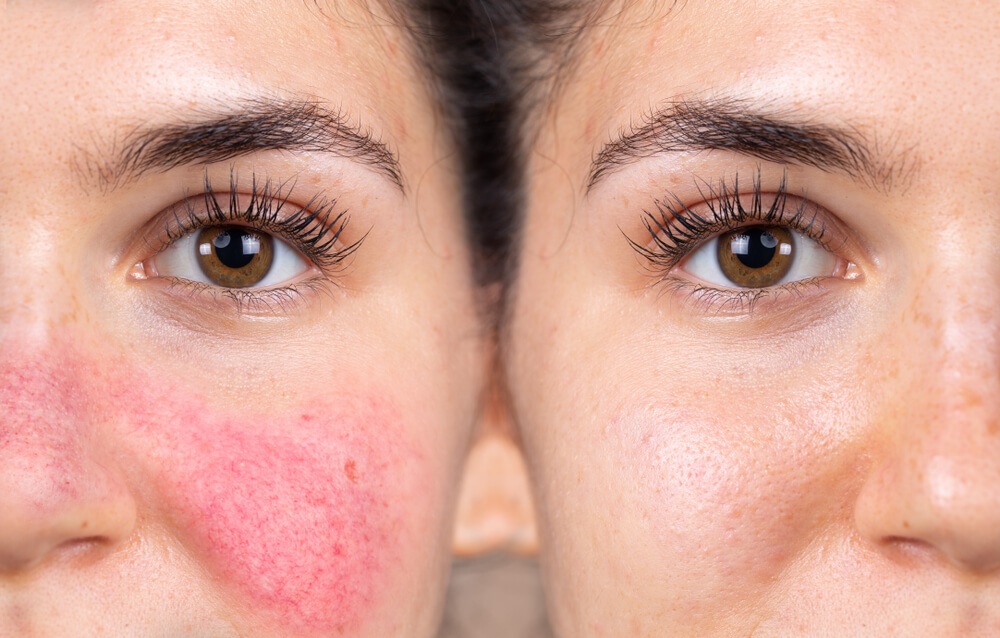Copyright © VSM Pharmacy Limited. All rights reserved. vsmpharmacy.co.uk is a trading name of VSM Pharmacy Limited. Registered office: 124 Frimley Road, Camberley, Surrey, United Kingdom, GU15 2QN. Registered in England: company number 12182298.

When you develop a red rash on your face, a little research will probably indicate that it is either lupus or rosacea. But there is some confusion around the question of lupus rash vs rosacea and whether these two conditions are different. There are some key distinctions, and in this article we will explore what they are.
What is lupus rash?
Lupus is an autoimmune disorder. This means it occurs when the immune system identifies healthy tissue as foreign and begins attacking it. Consequently, you get lots of inflammation and tissue damage, presenting as a number of symptoms both mild and severe.
What are the symptoms?
Lupus has a cycle of flare-ups and remissions. Symptoms usually surface due to environmental triggers before reducing again as they go into remission.
There are two categories of lupus:
1. Cutaneous lupus erythematosus
This is the milder form of the condition, usually presenting as a bright red rash that can form anywhere on the body, including the face. This rash is usually the first symptom of lupus that leads to a diagnosis. Many patients with this form of the disease develop no further symptoms.
When the rash develops on the face, known as a malar rash, it is commonly referred to as a butterfly rash as it resembles a butterfly covering the nose and cheeks.
The symptoms can include:
2. Systemic lupus erythematosus
This is the more severe form of lupus, wherein the symptoms can vary from a mild rash to something life-threatening. The systemic damage from this form of lupus can involve vital organs like the heart and lungs as well as bodily systems like the nervous system or the blood.
Mild symptoms can include:
More severe symptoms include:
What causes lupus?
We do not yet know the cause of lupus but new discoveries are being made. It is believed to happen from a combination of genetics, hormonal factors, system intolerance and certain environmental factors like medications or UV exposure. If there is lupus in your family history, you may be more likely to develop it yourself with a certain trigger (like a virus).
Drug-induced lupus can come from medications used to treat high blood pressure or hypertension.
What is rosacea?
Rosacea is an inflammatory skin disease. It causes a deep red flushing of the nose, cheeks, forehead, eyes and chin. It tends to flare up and enter remission, similar to lupus, often triggered by things like alcohol, spicy foods or excessive UV exposure. Symptoms can be mild or severe, and it comes in four forms:
1. Erythematotelangiectatic rosacea (ETR)
Symptoms include:
2. Papulopustular rosacea
Symptoms include:
3. Phymatous rosacea
Symptoms include:
4. Ocular rosacea
Symptoms include:
What causes rosacea?
The specific cause of rosacea is not known, but research indicates that it emerges from a combination of genetics, problems with the immune system and environmental factors like UV exposure, food triggers, poor gut health and other related diseases.
Lupus rash vs rosacea: what’s the difference?
Both lupus and rosacea tend to present as a red rash that covers the cheeks and nose. But the two conditions have some distinct differences when you look a little closer at the symptoms.
Lupus is an autoimmune disease, while rosacea is an inflammatory skin condition. Lupus can damage the organs and other bodily systems while rosacea only affects the facial skin. In severe cases, lupus can be life-threatening.
Diagnostic criteria
Lupus
There are 11 criteria for diagnosing lupus, and at least 4 of them must be present. Biochemical tests are required, and the criteria include:
Rosacea
The criteria for diagnosing rosacea are split into diagnostic, major and secondary criteria. Physical examination is used and there should be 1 diagnostic criteria or 2 major.
Diagnostic:
Major:
Secondary:
Treatment
Another area of distinction when considering lupus rash vs rosacea is in the treatments offered. Rosacea has multiple subtypes that are all treated differently, while treatments for lupus depend on the severity of the symptoms.
Lupus treatments:
Rosacea treatments:
Conclusion
Lupus rash and rosacea have many similarities. The main one is that they present as a red flush or rash on the face, which gets worse in the sunlight. But the two diseases are actually very different in terms of what they are and how they develop.
Fortunately, both are very treatable, and it’s best to seek treatment early to avoid the symptoms getting worse or the disease progressing. VSM is the pharmacy Camberley, Farnborough and Frimley residents can count on for help with a wide range of concerns including lupus and rosacea. If you are concerned, come and speak to a pharmacist for advice. You can even enquire online today and visit our Camberley pharmacy at a time that suits you.

Copyright © VSM Pharmacy Limited. All rights reserved. vsmpharmacy.co.uk is a trading name of VSM Pharmacy Limited. Registered office: 124 Frimley Road, Camberley, Surrey, United Kingdom, GU15 2QN. Registered in England: company number 12182298.

To provide the best experiences, we and our partners use technologies like cookies to store and/or access device information. Consenting to these technologies will allow us and our partners to process personal data such as browsing behavior or unique IDs on this site and show (non-) personalized ads. Not consenting or withdrawing consent, may adversely affect certain features and functions.
Click below to consent to the above or make granular choices. Your choices will be applied to this site only. You can change your settings at any time, including withdrawing your consent, by using the toggles on the Cookie Policy, or by clicking on the manage consent button at the bottom of the screen.